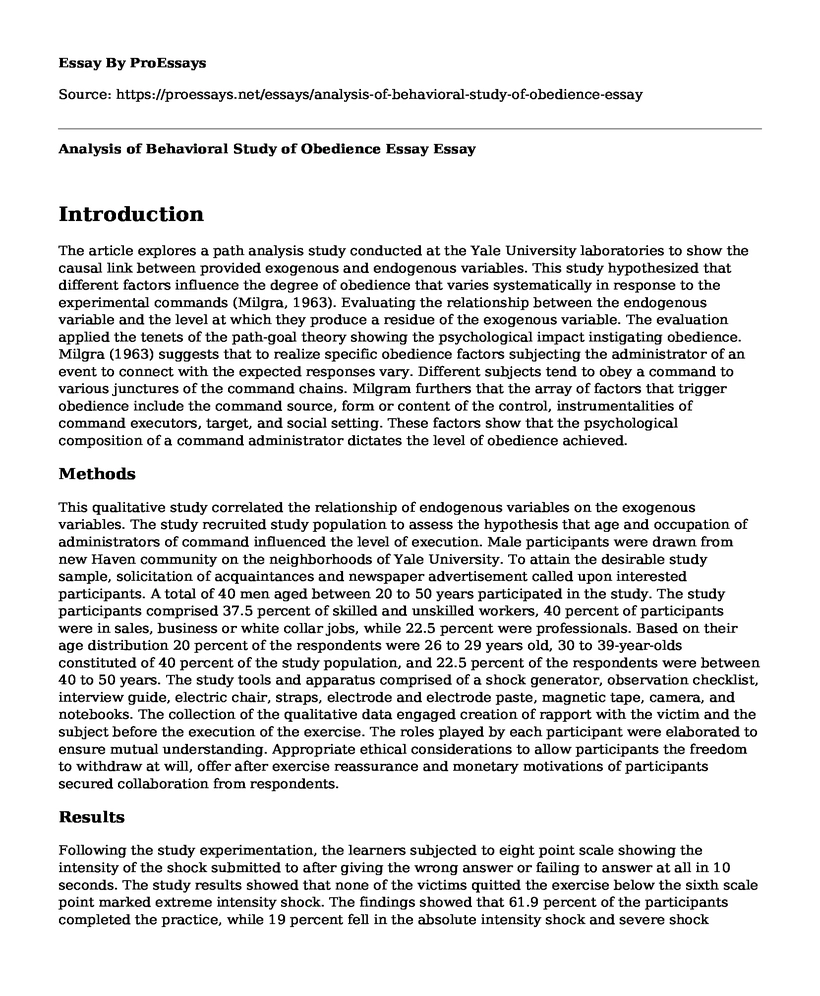Introduction
The article explores a path analysis study conducted at the Yale University laboratories to show the causal link between provided exogenous and endogenous variables. This study hypothesized that different factors influence the degree of obedience that varies systematically in response to the experimental commands (Milgra, 1963). Evaluating the relationship between the endogenous variable and the level at which they produce a residue of the exogenous variable. The evaluation applied the tenets of the path-goal theory showing the psychological impact instigating obedience. Milgra (1963) suggests that to realize specific obedience factors subjecting the administrator of an event to connect with the expected responses vary. Different subjects tend to obey a command to various junctures of the command chains. Milgram furthers that the array of factors that trigger obedience include the command source, form or content of the control, instrumentalities of command executors, target, and social setting. These factors show that the psychological composition of a command administrator dictates the level of obedience achieved.
Methods
This qualitative study correlated the relationship of endogenous variables on the exogenous variables. The study recruited study population to assess the hypothesis that age and occupation of administrators of command influenced the level of execution. Male participants were drawn from new Haven community on the neighborhoods of Yale University. To attain the desirable study sample, solicitation of acquaintances and newspaper advertisement called upon interested participants. A total of 40 men aged between 20 to 50 years participated in the study. The study participants comprised 37.5 percent of skilled and unskilled workers, 40 percent of participants were in sales, business or white collar jobs, while 22.5 percent were professionals. Based on their age distribution 20 percent of the respondents were 26 to 29 years old, 30 to 39-year-olds constituted of 40 percent of the study population, and 22.5 percent of the respondents were between 40 to 50 years. The study tools and apparatus comprised of a shock generator, observation checklist, interview guide, electric chair, straps, electrode and electrode paste, magnetic tape, camera, and notebooks. The collection of the qualitative data engaged creation of rapport with the victim and the subject before the execution of the exercise. The roles played by each participant were elaborated to ensure mutual understanding. Appropriate ethical considerations to allow participants the freedom to withdraw at will, offer after exercise reassurance and monetary motivations of participants secured collaboration from respondents.
Results
Following the study experimentation, the learners subjected to eight point scale showing the intensity of the shock submitted to after giving the wrong answer or failing to answer at all in 10 seconds. The study results showed that none of the victims quitted the exercise below the sixth scale point marked extreme intensity shock. The findings showed that 61.9 percent of the participants completed the practice, while 19 percent fell in the absolute intensity shock and severe shock respectively. The success rate of the study showed a significant relationship between the respondents' age and their occupation as well as their probability to sustain through the experiment process. The results implied that a majority of the participants moved through all the stages of the shock scale to show a high level of obedience and opposed to this showing defiance.
Criticisms
The experience conducted in this study achieved tremendous success with the high level of obedience attended compared to the level of defiance realized. However, specific methods used in this study failed to conform to ethical standard on social science research. For instance, the participant's recruitments were unable to enlighten potential respondents on the full intention of the study. The affiliating institution, Yale University failed to take full responsibilities of the study consequences. For the success and ethical consideration of the survey, the respondents should have access to the roles they play in the study from the onset of the study. The affiliation institution should be accountable for the research and take responsibilities of the study outcomes. The study delimited itself to male subjects while incorporation of females would have shown the coefficient correlation of the gender and obedience.
Conclusions
The results of this study give an insight into the principles of pain and obedience. It shows that personal characterizes like age and occupation offered resilience to the level different objects are subject to extreme conditions and their policy of compliance and social discipline.
References
Milgram, S. (1963). Behavioral study of obedience. Journal of Abnormal and Social Psychology, 67, 371-378.
Cite this page
Analysis of Behavioral Study of Obedience Essay. (2022, Mar 29). Retrieved from https://proessays.net/essays/analysis-of-behavioral-study-of-obedience-essay
If you are the original author of this essay and no longer wish to have it published on the ProEssays website, please click below to request its removal:
- The Manual to Success Essay
- Behavior Analysis Case Studies Paper Example
- Patient With Social Anxiety Disorder Case Study
- Essay Sample on Depression: Men vs Women - Symptoms, Coping, & Causes
- Essay Sample on Aging: From Birth to Death - What Causes It?
- Essay Sample on Group Therapy: A Psychotherapeutic Approach to Treating Addiction
- Origin & Control of Human Behavior: An Interdisciplinary Look - Essay Sample







